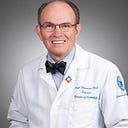Remember the Thyroid to Avoid Public Humiliation
George H.W. Bush was President, and I had a full head of hair so I occasionally did television commentary at distance running events for ABC and was also an infrequent medical “expert” for Good Morning America (GMA). It was May 1991 when President Bush developed atrial fibrillation (AF) while jogging at Camp David and. GMA wanted me in NYC the next morning to discuss AF. I was at Brown University and had an NIH grant examining how distance runners metabolized HDL cholesterol. I had just spent a week centrifuging runners’ HDL out of their plasma and labeling the HDL with radioactive iodine 125. I was scheduled to inject the runners the next morning so we could determine how rapidly the runners catabolized the HDL protein. (We ultimately showed that runners catabolize HDL proteins more slowly{1}). I explained that I could not go to NYC so ABC decided to send a TV truck to Providence. They wanted me on air at 7:05 AM. I called our research subjects and arranged for them come to the research lab starting at 4:30 AM so that my last injection would start at 6:45 AM. Getting all the subjects injected by 7 was no small feat because I had to get the intravenous line started and make sure it was flowing well so that I did not inject the radioactive HDL any place but in the vein. Unfortunately, the last subject was late so I ran around like crazy getting him going and the infusion done. I ran downstairs to the TV truck, combined my hair (those were the days) and at 7:05 AM started answering questions about atrial fibrillation. I did pretty well until Charlie Gibson asked about the causes of atrial fibrillation. I discussed enlargement of the atrium, alcohol, and other possible causes but never mentioned hyperthyroidism. So what did George W. H. Bush have? Hyperthyroidism. Within minutes my office phone was ringing with all my “friends” from around the country reminding me that I had forgotten hyperthyroidism. So, when I lecture about atrial fibrillation in athletes, an area of interest since 2009,{2} I always start the lecture with a slide of George H. W. Bush. So, here is my skinny on what cardiologists need to know about the thyroid to avoid humiliating themselves on national TV.
· The average dose of thyroid in the US is 112 mcgs. Patients taking less are more likely to be hypothyroid and patients taking more are more likely to be hyperthyroid.
· Everyone with AF needs at least a TSH. It used to be that clinicians would dismiss hyperthyroidism if the patient did not appear hyperthyroid, but “apathetic hyperthyroidism” is so common, especially in the elderly, that a TSH is always mandatory.
· Everyone with any lipid disorder also needs a TSH. Hypothyroidism reduces LDL receptor activity by reducing expression of the LDL receptor gene.{3} Hypothyroidism also can increase TG levels, so “every patient with a lipid disorder is hypothyroid until proven otherwise”.
· Amiodorone is loaded with iodine — 37% by weight {4} and iodine can cause both hypo and hyperthyroidism. Excess iodine inhibits thyroid synthesis, the Woff-Chaikoff effect, which is why iodine is part of the treatment for thyroid storm. Iodine can also cause thyrotoxicosis, the “Jod-Bsedow” phenomenon, which happens in patients who have are subclincal hyperthyroidism, but not have enough iodine to become toxic. Consequently, amiodorone can also cause both hypo and hyperthyroidism. The contrast used in angiography also contains iodine so contrast can affect thyroid function, something to remember if a patient becomes hyperthyroid not long after angiography.
· Hypothyroidism also increases lipoprotein (a), which is increasingly recognized as an important risk factor in CAD.{5} That may be another reason, besides the LDL, that hypothyroid patients get accelerated atherosclerosis.
So, remember George H.W. to avoid missing thyroid disease in cardiac patients. .
1. Thompson PD, Cullinane EM, Sady SP, Flynn MM, Chenevert CB, Herbert PN. High density lipoprotein metabolism in endurance athletes and sedentary men. Circulation 1991;84:140–52.
2. Sorokin AV, Araujo CG, Zweibel S, Thompson PD. Atrial fibrillation in endurance-trained athletes. Br J Sports Med 2011;45:185–8.
3. STAEL B, TOL AV, CHAN L, WILL H, Verhoeven G, Auwerx J. Alterations in thyroid status modulate apolipoprotein, hepatic triglyceride lipase, and low density lipoprotein receptor in rats. Endocrinology 1990;127:1144–52.
4. Burch HB. Drug Effects on the Thyroid. N Engl J Med 2019;381:749–61.
5. Tsimikas S. A test in context: lipoprotein (a): diagnosis, prognosis, controversies, and emerging therapies. J Am Coll Cardiol 2017;69:692–711.
